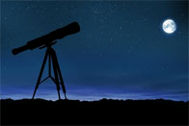| Ablation |
A process by where the atmosphere melts away and removes the surface material of an incoming meteorite. |
| Absolute Magnitude |
A scale for measuring the actual brightness of a celestial object without accounting for the distance of the object. Absolute magnitude measures how bright an object would appear if it were exactly 10 parsecs (about 33 light-years) away from Earth. On this scale, the Sun has an absolute magnitude of +4.8 while it has an apparent magnitude of -26.7 because it is so close. |
| Absolute Zero |
The temperature at which the motion of all atoms and molecules stops and no heat is given off. Absolute zero is reached at 0 degrees Kelvin or -273.16 degrees Celsius. |
| Accretion |
The process by where dust and gas accumulated into larger bodies such as stars and planets. |
| Accretion Disk |
A disk of gas that accumulates around a center of gravitational attraction, such as a white dwarf, neutron star, or black hole. As the gas spirals in, it becomes hot and emits light or even X-radiation. |
| Achondrite |
A stone meteorite that contains no chondrules. |
| Albedo |
The reflective property of a non-luminous object. A perfect mirror would have an albedo of 100% while a black hole would have an albedo of 0%. |
| Albedo Feature |
A dark or light marking on the surface of an object that may or may not be a geological or topographical feature. |
| Alpha Centauri |
Binary star system. Near to a Cen A & a Cen B |
| Alt Azimuth |
Mount type |
| Altitude |
The angular elevation of an object above the horizon. |
| Andromeda |
Nearest galaxy (apart from Milky Way). 2.6 megalight-years from Earth |
| Antimatter |
Matter consisting of particles with charges opposite that of ordinary matter. In antimatter, protons have a negative charge while electrons have a positive charge. |
| Antipodal Point |
A point that is on the direct opposite side of a planet. |
| Apastron |
The point of greatest separation of two stars, such as in a binary star system. |
| Aperture |
The size of the opening through which light passes in an optical instrument such as a camera or telescope. A higher number represents a smaller opening while a lower number represents a larger opening. |
| Aphelion |
Point in orbit furthest from Sun. [Greek Ap (away), hellion (sun)] |
| Apoapsis |
Point in orbit furthest from body it is orbiting. |
| Apogee |
Point in orbit furthest from Earth. [Greek Ap (away), geo (earth)] |
| Apparent Magnitude |
The apparent brightness of an object in the sky as it appears to an observer on Earth. Bright objects have a low apparent magnitude while dim objects will have a higher apparent magnitude. |
| Apparition |
Period and an object is viewable in the sky. |
| Arc-minute |
Angular measure, 1/60 of a degree. |
| Arc-second |
Angular measure, 1/3600 of a degree. |
| Asteroid |
A small planetary body in orbit around the Sun, larger than a meteoroid but smaller than a planet. Most asteroids can be found in a belt between the orbits of Mars and Jupiter. The orbits of some asteroids take them close to the Sun, which also takes them across the paths of the planets. |
| Asteroid belt |
Between Earth and Jupiter. |
| Astrochemistry |
The branch of science that explores the chemical interactions between dust and gas interspersed between the stars. |
| Astronomical Unit |
Distance measure. The average distance of the Earth from the Sun. 149.597 870 700 Gm (Giga = 10^9) |
| Atmosphere |
A layer of gases surrounding a planet, moon, or star. The Earth's atmosphere is 120 miles thick and is composed mainly of nitrogen, oxygen, carbon dioxide, and a few other trace gases. |
| Aurora |
A glow in a planet's ionosphere caused by the interaction between the planet's magnetic field and charged particles from the Sun. This phenomenon is known as the Aurora Borealis in the Earth's northern hemisphere and the Aurora Australis in the Earth's Southern Hemisphere. |
| Aurora Australis |
Also known as the southern lights, this is an atmospheric phenomenon that displays a diffuse glow in the sky in the southern hemisphere. It is caused by charged particles from the Sun as they interact with the Earth's magnetic field. Known as the Aurora Borealis in the northern hemisphere. |
| Aurora Borealis |
Also known as the northern lights, this is an atmospheric phenomenon that displays a diffuse glow in the sky in the northern hemisphere. It is caused by charged particles from the Sun as they interact with the Earth's magnetic field. Known as the Aurora Australis in the southern hemisphere. |
| Axis |
Also known as the poles, this is an imaginary line through the center of rotation of an object. |
| Azimuth |
The angular distance of an object around or parallel to the horizon from a predefined zero point. |

